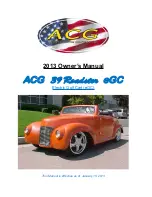
•
ON ALL VEHICLES, TURN OFF ALL ACCESSORIES BEFORE CHARGING
BATTERIES.
•
RECYCLE OR DISPOSE OF DISCARDED BATTERIES IN ACCORDANCE WITH
LOCAL, STATE, AND FEDERAL REGULATIONS.
The batteries are 12 Volts each, and are deep cycle batteries, specially built for electric
vehicle application. Automotive batteries should never be used.
New batteries will not deliver their full capabilities until they have been discharged
and recharged 20 to 50 times. To obtain the maximum service life from new
batteries, restrict vehicles with new batteries to 18 holes of use between charges n
the first two months of operation. Batteries should be fully charged before first
use of new vehicle, before first use of a vehicle after storage, and before releasing
vehicle for use each day.
Battery Care
To keep batteries in good working condition, follow this maintenance program on a
regular basis:
The batteries should be kept clean and free of corrosion. Wash tops and terminals of
batteries with a solution of baking soda and water (1 cup baking soda per 1 gallon of
water) once per week. Rinse solution off of the batteries. See following NOTE.
•
DO NOT ALLOW BAKING SODA SOLUTION TO ENTER THE BATTERY.
•
DISPOSE OF WASTE WATER PROPERLY.
Be
sure terminals are tight. Let the terminals dry and then spray them with Battery
Protector Spray.
The electrolyte level in the batteries should be checked weekly (see figure 6 for proper
level). Add the water only after charging unless the electrolyte level is below the top of
the plates. In this case, add just enough water to cover the plates, charge and then
check the level again. Never charge batteries if plates are exposed above electrolyte
level. For best battery life, add only distilled water. See following NOTE.
•
A BATTERY WATERING GUN OR BOTTLE IS AVAILABLE AT REGAL
RESEARCH OR MANY AUTO PART DEALERS.
25
Содержание 330100001101
Страница 8: ...8...


























